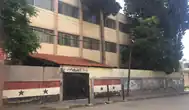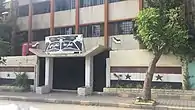Homs school bombing
The Homs school bombing occurred on 1 October 2014 in Homs, Syria in an Alawite majority neighborhood during the Syrian civil war.[1][2] The attacker initially detonated an IED that was in front of the Akrama al-Makhzumi Al-Muhdatha elementary school.[lower-alpha 1] Then he blew himself up at another gate of a nearby school, Akrama al-Makhzumi.[5][6] The double bombing killed 54 people: 47 children, 3 members of security forces and 4 adult civilians.[1][5] The attack was the deadliest strike to occur in a government controlled area in over a year, with no group immediately taking responsibility.[2]
| Homs school bombing | |
|---|---|
The attacker detonated an IED in front of the school (left), then blew himself up at the gate of another school (right) | |
| Location | Akrama al-Makhzumi, Homs, Syria |
| Coordinates | 34°42′40″N 36°42′51″E |
| Date | 1 October 2014 ~12:00 (UTC+02:00) |
| Target | Akrama al-Makhzumi elementary school |
Attack type | IED, suicide bomber |
| Deaths | 54 |
| Motive | Sectarian |
Public Protests
Following the bombing, several protests broke out because of the government's failure to prevent the attack. Although most protestors where reportedly pro-government, many called for the removal of Talal Al-Barazi who was the provincial governor for the Homs Governorate. Talal was never removed from office. Protests never turned to be anti-government.[7]
International Reactions
The Syrian Foreign Ministry sent letters to the United Nations and Security Council, in which they accused the so-called "moderate armed opposition" of planning and executing the attacks.[8] However, the members of the Security Council, Secretary-General Ban Ki-moon and Special Representative Leila Zerrougui all condemned the attack against civilians including children.[9]
In addition, the British Minister for the Middle East Tobias Ellwood mentioned: "I condemn recent attacks in Syria targeting civilians. These have included the bombing of a school in Homs, the continued use of indiscriminate barrel bombs by the Assad regime in Aleppo province, and the siege around Kobane. Such attacks underline the dreadful toll that the conflict continues to take on the Syrian people and we call on all parties to end the deliberate targeting of civilians. The UK will continue to press for those responsible for such attacks to be held accountable and to press for a political solution to bring to an end the suffering of the Syrian people."[10]
Possible perpetrators
According to local security sources, eleven suspects were apprehended in Talkalakh District on the border with Lebanon who were related to Jund al-Sham, a group linked to the Abdullah Azzam Brigades.[11]
Notes
- Both school and neighbourhood were named after Ikrima ibn Abi Jahl. Al-Muhdatha was later renamed after Iyad Kamel Harfoush, a major died in Homs during the civil war in 2011.[3][4]
References
- "Protests As 47 Children Killed In School Bombing | World News | Sky News". news.sky.com. Retrieved 2019-11-28.
- "41 children killed in Syria school bombing". Middle East Eye. February 13, 2015. Retrieved July 29, 2021.
- مدرسة الشهيد الرائد إياد كامل حرفوش (عكرمة المحدثة). rawabet.org (in Arabic).
- اياد كامل حرفوش. dampress.net (in Arabic).
- "Double bombing kills at least 41 children at school in Syria". ABC News (Australian Broadcasting Corporation). Retrieved 2019-11-28.
- "Children killed in Homs double blast". www.aljazeera.com. Retrieved 2021-07-27.
- Barnard, Anne; Ghannam, Mohammad (2014-10-02). "Protests Erupt in Homs Over Bombings That Killed Dozens of Syrian Schoolchildren". The New York Times. ISSN 0362-4331. Retrieved 2021-07-27.
- الخارجية: ما يروق للغرب وأدواته في المنطقة تسميتها “المعارضة المسلحة المعتدلة” نفذت الجريمة الإرهابية النكراء بحق الأطفال في حمص. SANA (in Arabic). 3 October 2014.
- "Syria: Security Council condemns bomb attacks on school in Homs". United Nations. 3 October 2014.
- "Foreign Office Minister condemns Syria violence and attack". gov.uk. 2 October 2014.
- "Syrian Rebels Kill 45 Civilians at a Homs Children's School". almasdarnews.com. 2014-10-01. Archived from the original on 2017-01-07. Retrieved 2017-01-06.

